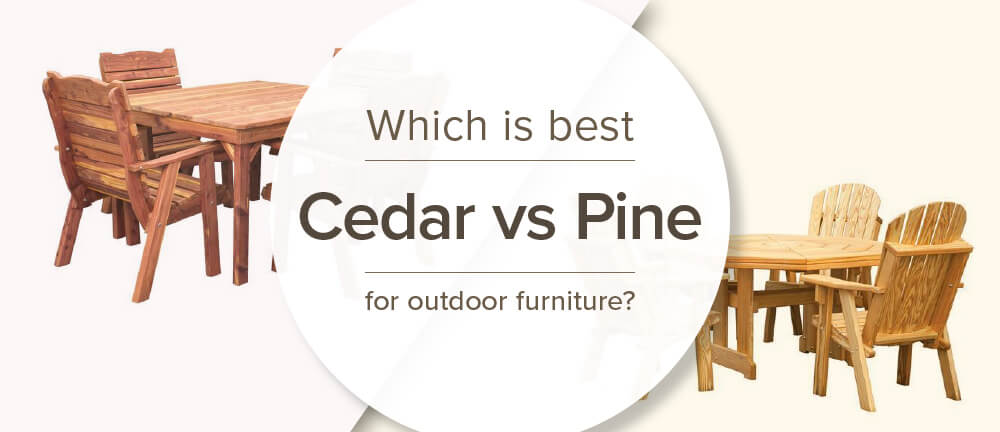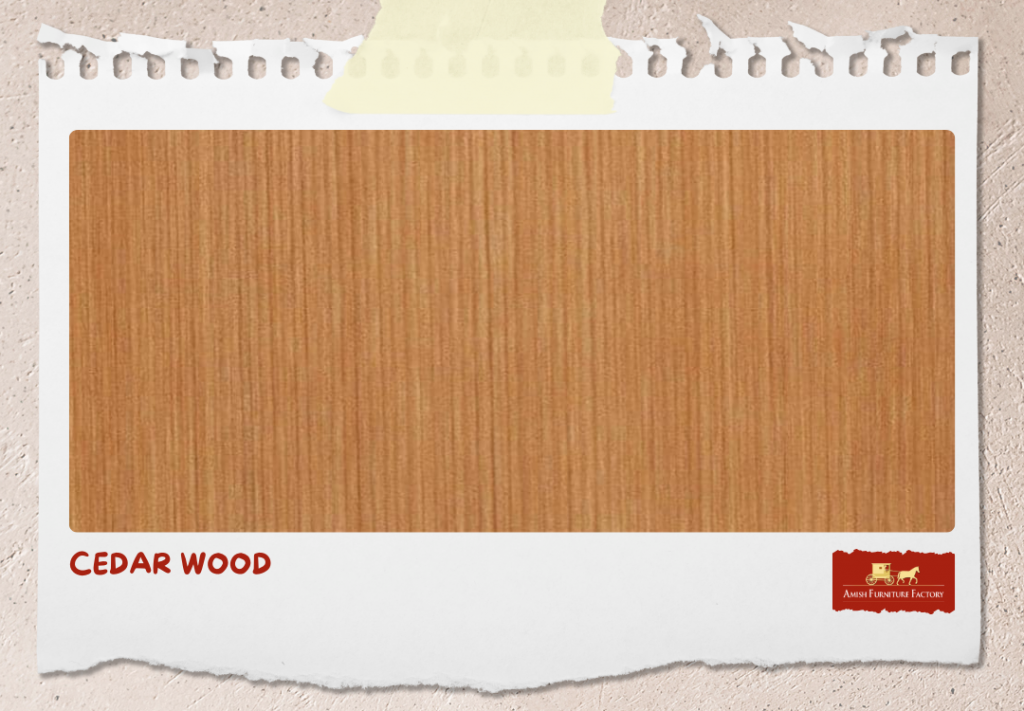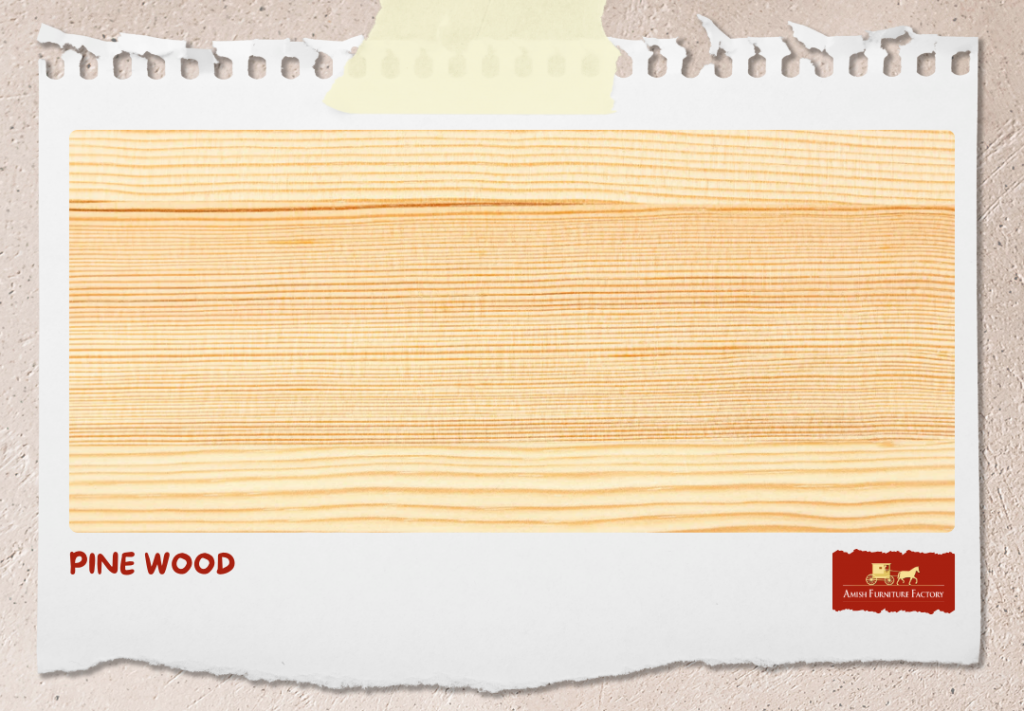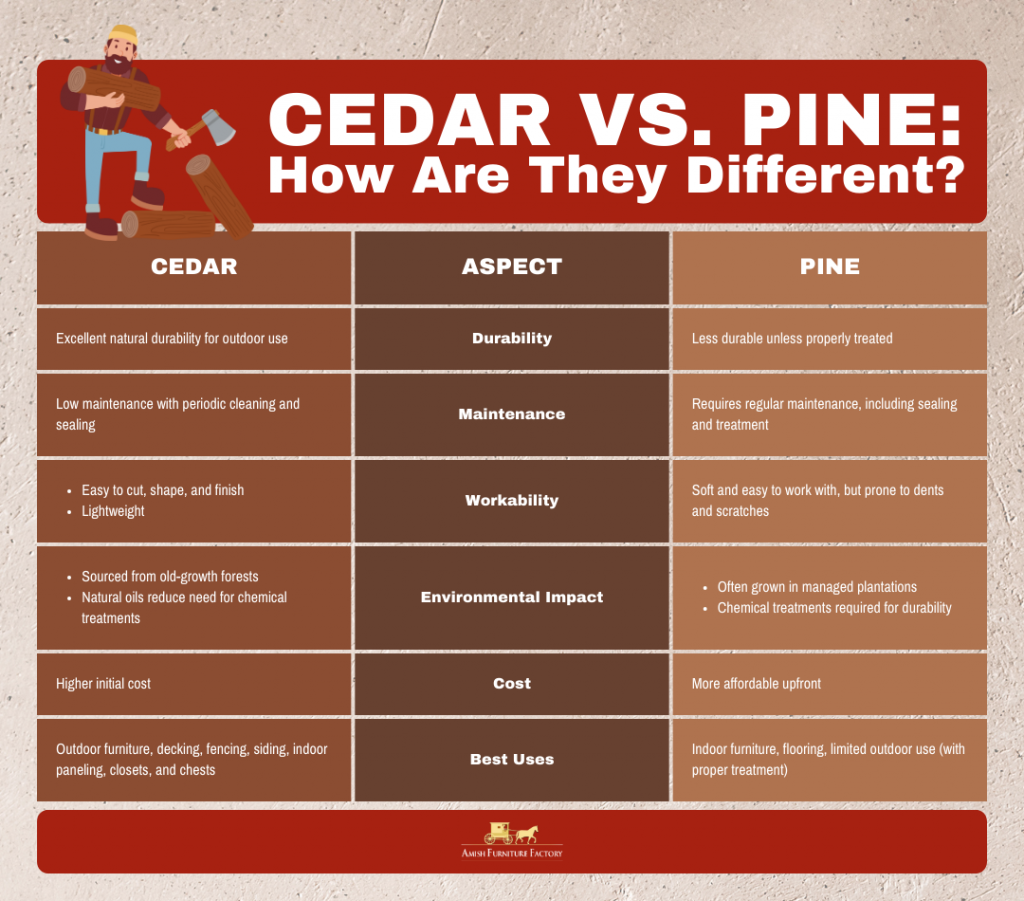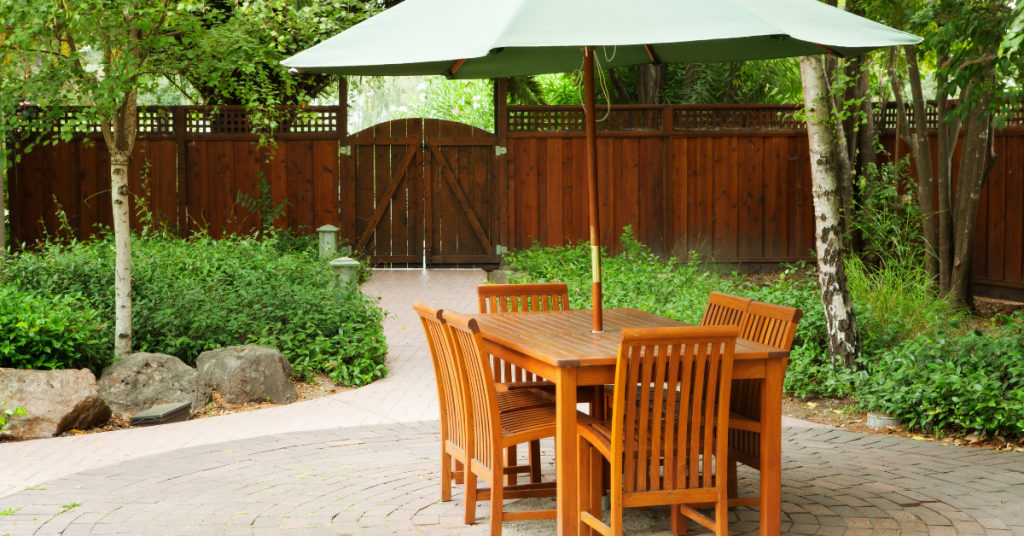
Choosing the right wood for your outdoor furniture is crucial for durability and aesthetics. Cedar and pine are two popular options, each with its unique benefits and characteristics. Cedar is known for its natural resistance to decay and insects, while pine offers a more affordable yet sturdy alternative. Understanding the differences between these two woods will help you make an informed decision, ensuring your outdoor space is both beautiful and long-lasting.
Key Takeaways:
- Cedar is naturally resistant to decay and insects, making it an excellent choice for outdoor furniture, while pine requires proper treatment to enhance its durability for outdoor use.
- Cedar is low maintenance, needing only periodic cleaning and sealing. In contrast, pine requires more regular maintenance, including sealing and treatment, to maintain its durability and appearance.
- Pine, being more affordable, is a budget-friendly option but may incur additional maintenance costs over time. Cedar generally has a higher initial cost due to its natural durability and desirable characteristics.
This article explores the characteristics of cedar and pine, compare their costs and workability, and discuss their environmental impact. Whether you’re planning a new deck or selecting the perfect patio set, understanding these wood types will help you make an informed decision for your outdoor space.
Overview of Cedar and Pine
Cedar and pine are two popular choices for outdoor furniture, each offering distinct benefits. Below is a closer look at the characteristics, visual appearances, and common uses of both types of wood:
Cedar
Cedar is renowned for its natural resistance to decay and insects, making it an excellent choice for outdoor furniture. It features a distinctive aroma and a rich reddish-brown color, often with streaks of lighter hues that add depth and warmth to its appearance. The texture of cedar is relatively fine and uniform, which adds to its aesthetic appeal.
There are several types of cedar wood, with Western Red Cedar and Eastern Red Cedar being the most common. Western Red Cedar typically shows a softer reddish-brown color and is prized for its durability and resistance to moisture, making it ideal for outdoor conditions. Eastern Red Cedar, on the other hand, exhibits a more vibrant reddish hue with occasional purplish tones and is valued for its rich color and aromatic properties.
Cedar is commonly used for a variety of outdoor projects, including furniture, decking, and fencing. Its natural oils help protect it from the elements, reducing the need for chemical treatments. Additionally, cedar is relatively lightweight and easy to work with, making it a favorite among DIY enthusiasts and professionals alike.
Pine
Pine wood is a versatile and widely available option that is primarily used for indoor furniture and flooring but also adapted for outdoor use. It is generally lighter in color, featuring hues that range from creamy white to soft yellow. Pine has a straight grain with a uniform texture, which makes it visually appealing under a finish. The knots and natural grain variations can add character and rustic charm to the wood.
There are different types of pine wood, including White Pine and Yellow Pine. White Pine is noted for its softness and ease of shaping, making it ideal for intricate woodworking projects. Yellow Pine, with its denser and more robust nature, offers enhanced durability and is often chosen for more demanding applications.
Pine’s affordability and the ease with which it can be stained or painted make it a popular choice for budget-conscious projects. Though naturally susceptible to moisture and pests, pine can be treated to enhance its resistance to the elements, thereby extending its viability for outdoor use.
Comparing Cedar and Pine
When choosing between cedar and pine for your outdoor furniture, it’s important to consider cost, workability, and maintenance. Here are the aspects you should look into so you can make an informed decision.
Cost Comparison
Cedar is generally priced higher than pine, reflecting its natural durability and desirability for outdoor use. In 2024, the cost of cedar wood varies depending on the type and quality. Here’s a breakdown of average prices per board foot for different grades and thicknesses:
- Standard Cedar Lumber: The price ranges from $3 to $7 per board foot. Premium quality boards can be more expensive, up to $10 or more per board foot.
- 4/4 Cedar Lumber: Typically priced between $4 to $6 per board foot.
- 5/4 Cedar Lumber: Prices range from $4 to $12 per linear foot, depending on the length and quality.
- 6/4 Cedar Lumber: Generally costs between $4.50 and $5 per board foot, with higher quality wood reaching up to $12 per board foot.
- 8/4 Cedar Lumber: Prices range from $7 to $12 per board foot.
Cedar’s resistance to decay and insects means that it often doesn’t require as much maintenance or additional treatment, which can help offset some of the higher initial costs over time.
On the other hand, pine is typically more affordable, making it an attractive option for those on a budget or undertaking large-scale projects. The average cost of pine wood varies depending on the type and quality. Here are the typical price ranges per board foot for different kinds of pine wood:
- White Pine: Generally priced around $3.50 to $4.50 per board foot.
- Yellow Pine: Costs approximately $2.50 to $3.50 per board foot.
These prices are influenced by factors such as the grade of the wood, the specific supplier, and regional availability.
Keep in mind that it’s important to consider the long-term investment, as pine may require more frequent maintenance and treatments to enhance its resistance to moisture and pests. This ongoing care can add to the overall cost in the long run.
Workability and Maintenance
Cedar is known for its ease of workability. It is lightweight and has a fine, straight grain, making it easy to cut, shape, and finish. Additionally, cedar’s natural oils help preserve the wood, reducing the need for frequent maintenance. Regular cleaning and occasional reapplication of a protective finish can keep cedar furniture looking great for years.
Pine, being softer, is also relatively easy to work with, making it a good choice for those new to woodworking. However, its softness means it can dent and scratch more easily. Pine requires regular maintenance to protect it from the elements, including sealing and staining. Treated pine can withstand outdoor conditions better, but untreated pine will need more frequent attention to prevent decay and damage from pests.
Environmental Impact and Sustainability
When it comes to environmental impact, cedar and pine have different considerations.
Cedar is often sourced from old-growth forests, particularly Western Red Cedar, which raises concerns about deforestation and habitat destruction. However, cedar’s natural durability reduces the need for chemical treatments, which can be beneficial for the environment. To ensure sustainable sourcing, look for certifications like the Forest Stewardship Council (FSC) or the Sustainable Forestry Initiative (SFI), which indicate that the wood has been harvested responsibly.
Pine, on the other hand, is more commonly grown in managed plantations, which can help reduce the pressure on natural forests. These plantations are typically managed to promote sustainability and can be a more environmentally friendly option. However, pine often requires chemical treatments to enhance its durability for outdoor use, which can have environmental implications. As with cedar, choosing FSC or SFI certified pine can help ensure that the wood is sourced from responsibly managed forests.
Best Uses for Cedar and Pine
Cedar and pine each have ideal applications based on their characteristics and properties.
Ideal Applications for Cedar
Cedar is highly valued for outdoor projects due to its natural resistance to decay and insects. It is commonly used for decks, fences, and siding, where its durability and aesthetic appeal make it an excellent choice. Cedar’s ability to withstand moisture and harsh weather conditions without extensive treatment makes it particularly suitable for these applications.
Indoors, cedar is often used for furniture and paneling. Its pleasant aroma and attractive grain make it a popular choice for closets, chests, and other furniture pieces. Cedar paneling adds a warm, rustic touch to interior spaces and can help repel insects, making it practical for storage areas.
Ideal Applications for Pine
Pine is versatile and widely used for indoor projects such as furniture and flooring. Its affordability and ease of finishing allow for a wide range of design possibilities. Pine furniture can be stained or painted to match various interior styles, and its softer nature makes it easier to shape and work with.
For outdoor use, pine is less common due to its susceptibility to moisture and pests. However, when properly treated, pine can be used for some outdoor projects like picnic tables or garden furniture. It’s essential to apply treatments such as pressure treatment or sealing to protect the wood from the elements and extend its lifespan in outdoor settings.
Conclusion: Making the Right Choice for Your Outdoor Space
The choice between cedar and pine for your outdoor furniture ultimately depends on your specific needs and preferences. Cedar offers natural durability and low maintenance, making it ideal for those seeking long-lasting, worry-free outdoor furniture. Its resistance to decay and insects, combined with its beautiful appearance, makes it a premium choice despite its higher initial cost.
On the other hand, pine is an affordable and versatile option, suitable for budget-conscious projects or those who enjoy regular maintenance and care. With proper treatment, pine can be a durable and attractive solution for outdoor settings.
By understanding the unique characteristics, costs, and maintenance requirements of cedar and pine, you can make an informed decision that best suits your outdoor space, ensuring it remains both functional and visually appealing for years to come.
FAQs
How does weather affect cedar and pine furniture over time?
Cedar furniture naturally resists decay and insect damage, making it well-suited for outdoor use. Over time, exposure to the elements can cause cedar to weather to a silvery-gray color, but it remains structurally sound. Pine furniture, unless properly treated, is more susceptible to moisture damage and insect infestation.
Can cedar and pine furniture be painted or stained to enhance durability?
Yes, both cedar and pine furniture can be painted or stained to enhance durability and appearance. Applying paint or stain helps protect the wood from moisture, UV rays, and wear and tear. For cedar, staining is often preferred to preserve its natural beauty, while pine can be painted or stained depending on the desired look.
What are the safety considerations when using treated pine outdoors?
When using treated pine outdoors, it’s important to ensure the wood is properly treated with chemicals that protect against decay and insects. Avoid burning treated pine, as the chemicals can release toxic fumes. Additionally, use caution when cutting or sanding treated pine, wearing protective gear to avoid inhaling dust.
How do cedar and pine respond to extreme climates like heavy rainfall or dry heat?
Cedar performs well in extreme climates due to its natural resistance to moisture and decay. It can withstand heavy rainfall and dry heat without significant deterioration. Pine, however, needs to be adequately treated to handle extreme conditions.
Are there specific care products recommended for cedar and pine outdoor furniture?
For cedar furniture, using a protective sealant or stain designed for outdoor wood can help maintain its color and protect it from UV rays. Regular cleaning with mild soap and water is also recommended. For pine, using a water-repellent sealant or outdoor wood preservative is crucial to prevent moisture damage. Additionally, applying a quality outdoor paint or stain can enhance its durability and appearance.
